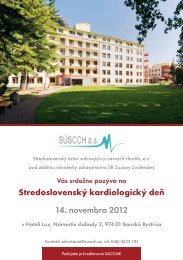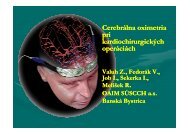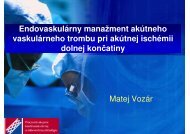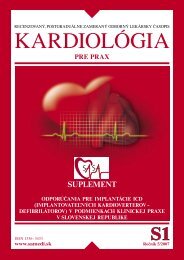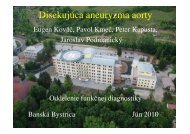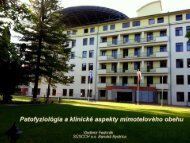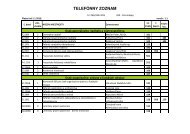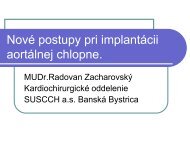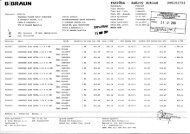Management of acute myocardial infarction in patients presenting ...
Management of acute myocardial infarction in patients presenting ...
Management of acute myocardial infarction in patients presenting ...
Create successful ePaper yourself
Turn your PDF publications into a flip-book with our unique Google optimized e-Paper software.
ESC Guidel<strong>in</strong>es 2923<br />
Table 13 Recommendations for prevention and<br />
treatment <strong>of</strong> no-reflow<br />
Recommendations Class a Level b<br />
................................................................................<br />
Prevention<br />
Thrombus aspiration IIa B<br />
Abciximab 0.25 mg/kg bolus and 0.125 mg/kg/m<strong>in</strong> IIa B<br />
<strong>in</strong>fusion for 12–24 h<br />
................................................................................<br />
Treatment<br />
Adenos<strong>in</strong>e: 70 mg/kg/m<strong>in</strong> i.v. over 3 h dur<strong>in</strong>g and IIb B<br />
after PCI<br />
Adenos<strong>in</strong>e: <strong>in</strong>tracoronary bolus <strong>of</strong> 30–60 mg IIb C<br />
dur<strong>in</strong>g PCI<br />
Verapamil: <strong>in</strong>tracoronary bolus <strong>of</strong> 0.5–1 mg IIb C<br />
dur<strong>in</strong>g PCI<br />
a Class <strong>of</strong> recommendation.<br />
b Level <strong>of</strong> evidence.<br />
adjunctive devices for prevent<strong>in</strong>g distal embolization is discussed <strong>in</strong><br />
section D.1.d.<br />
e. Coronary bypass surgery<br />
The number <strong>of</strong> <strong>patients</strong> who need a coronary artery bypass graft<br />
(CABG) <strong>in</strong> the <strong>acute</strong> phase is limited, but CABG may be <strong>in</strong>dicated<br />
after failed PCI, coronary occlusion not amenable for PCI, presence<br />
<strong>of</strong> refractory symptoms after PCI, cardiogenic shock, or<br />
mechanical complications such as ventricular rupture, <strong>acute</strong><br />
mitral regurgitation, or ventricular septal defect. 112,113<br />
If a patient requires emergency stent<strong>in</strong>g <strong>of</strong> a culprit lesion <strong>in</strong> the<br />
sett<strong>in</strong>g <strong>of</strong> a STEMI but further surgical revascularization is already<br />
predictable <strong>in</strong> the near future, the use <strong>of</strong> bare metal stents<br />
<strong>in</strong>stead <strong>of</strong> drug-elut<strong>in</strong>g stents should be recommended to avoid<br />
the problem <strong>of</strong> <strong>acute</strong> perioperative stent thrombosis. In <strong>patients</strong><br />
with an <strong>in</strong>dication for CABG, e.g. multivessel disease, it is recommended<br />
to treat the <strong>in</strong>farct-related lesion by PCI and to perform<br />
CABG later <strong>in</strong> more stable conditions.<br />
2. Pump failure and shock<br />
a. Cl<strong>in</strong>ical features<br />
Heart failure is usually due to <strong>myocardial</strong> damage but may also be<br />
the consequence <strong>of</strong> arrhythmia or mechanical complications such<br />
as mitral regurgitation or ventricular septal defect. Heart failure<br />
dur<strong>in</strong>g the <strong>acute</strong> phase <strong>of</strong> STEMI is associated with a poor shortand<br />
long-term prognosis. 114 The cl<strong>in</strong>ical features are those <strong>of</strong><br />
breathlessness, s<strong>in</strong>us tachycardia, a third heart sound, and pulmonary<br />
rales, which are basal, but may extend throughout both lung<br />
fields. The degree <strong>of</strong> failure may be categorized accord<strong>in</strong>g to the<br />
Killip classification: class 1, no rales or third heart sound; class 2,<br />
pulmonary congestion with rales over ,50% <strong>of</strong> the lung fields<br />
or third heart sound; class 3, pulmonary oedema with rales over<br />
50% <strong>of</strong> the lung fields; class 4, shock. Haemodynamic states that<br />
can occur after STEMI are given <strong>in</strong> Table 14.<br />
General measures <strong>in</strong>clude monitor<strong>in</strong>g for arrhythmias, check<strong>in</strong>g<br />
for electrolyte abnormalities and for the presence <strong>of</strong> concomitant<br />
Table 14 Haemodynamic states<br />
Normal Normal blood pressure, heart and respiration<br />
rates, good peripheral circulation<br />
................................................................................<br />
Hyperdynamic Tachycardia, loud heart sounds, good peripheral<br />
state<br />
circulation<br />
................................................................................<br />
Hypotension<br />
Bradycardia ‘Warm hypotension’, bradycardia, venodilatation,<br />
normal jugular venous pressure, decreased<br />
tissue perfusion. Usually <strong>in</strong> <strong>in</strong>ferior <strong><strong>in</strong>farction</strong>,<br />
but may be provoked by opiates. Responds to<br />
atrop<strong>in</strong>e or pac<strong>in</strong>g<br />
Right ventricular<br />
<strong><strong>in</strong>farction</strong><br />
High jugular venous pressure, poor tissue<br />
perfusion or shock, bradycardia, hypotension<br />
Hypovolaemia Venoconstriction, low jugular venous pressure,<br />
poor tissue perfusion. Responds to fluid<br />
<strong>in</strong>fusion<br />
................................................................................<br />
Pump failure<br />
Pulmonary Tachycardia, tachypnoea, basal rales<br />
congestion<br />
Pulmonary Tachycardia, tachypnoea, rales over 50% <strong>of</strong> lung<br />
oedema<br />
fields<br />
................................................................................<br />
Cardiogenic Cl<strong>in</strong>ical signs <strong>of</strong> poor tissue perfusion (oliguria,<br />
shock<br />
decreased mentation), hypotension, small<br />
pulse pressure, tachycardia, pulmonary<br />
oedema<br />
conditions such as valvular dysfunction or pulmonary disease. Pulmonary<br />
congestion can be assessed by portable chest X-rays. Echocardiography<br />
is the key diagnostic tool and should be performed to<br />
assess the extent <strong>of</strong> <strong>myocardial</strong> damage and possible complications,<br />
such as mitral regurgitation and ventricular septal defect.<br />
b. Mild heart failure (Killip class II)<br />
Oxygen should be adm<strong>in</strong>istered early by mask or <strong>in</strong>tranasally, but<br />
caution is necessary <strong>in</strong> the presence <strong>of</strong> chronic pulmonary disease.<br />
Monitor<strong>in</strong>g blood oxygen saturation is <strong>in</strong>dicated.<br />
M<strong>in</strong>or degrees <strong>of</strong> failure <strong>of</strong>ten respond quickly to nitrates and<br />
diuretics, such as furosemide 20–40 mg given slowly i.v., repeated<br />
at 1–4 hourly <strong>in</strong>tervals, if necessary. Higher doses may be required<br />
<strong>in</strong> <strong>patients</strong> with renal failure or chronic use <strong>of</strong> diuretics. If there is<br />
no hypotension, i.v. nitrates are <strong>in</strong>dicated. The dose <strong>of</strong> nitrates<br />
should be titrated while monitor<strong>in</strong>g blood pressure to avoid hypotension.<br />
Angiotens<strong>in</strong>-convert<strong>in</strong>g enzyme (ACE) <strong>in</strong>hibitors [or an<br />
angiotens<strong>in</strong> receptor blocker (ARB) if ACE-<strong>in</strong>hibitors are not tolerated]<br />
should be <strong>in</strong>itiated with<strong>in</strong> 24 h <strong>in</strong> the absence <strong>of</strong> hypotension,<br />
hypovolaemia, or significant renal failure (Table 15). See also<br />
section D.5.<br />
c. Severe heart failure and shock (Killip class III and IV)<br />
Oxygen should be adm<strong>in</strong>istered and pulse oximetry is <strong>in</strong>dicated for<br />
monitor<strong>in</strong>g <strong>of</strong> oxygen saturation. Blood gases should be checked<br />
regularly, and cont<strong>in</strong>uous positive airway pressure or endotracheal<br />
<strong>in</strong>tubation with ventilatory support may be required. Non-<strong>in</strong>vasive<br />
ventilation should be considered as early as possible <strong>in</strong> every



